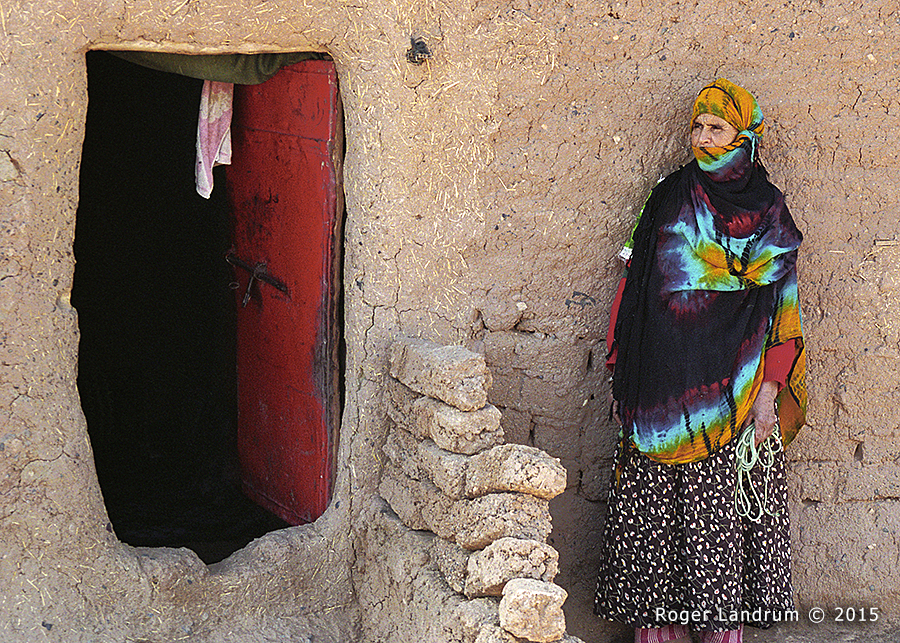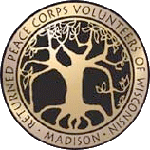Morocco

Morocco
In the bleak desert near the great sand dunes of Erg Chebbi in southeastern Morocco, a Berber woman with a flair for color and design leans against the wall of her adobe home. She is waiting for a ride to fetch water from a nearby well. Her traditional Berber cloak (halk), ankle-length trousers (chalwar), and headdress protect her from the intense heat and sun—and like the door of her home, they inject vivid color in this dun-colored landscape.
– Roger Landrum ©2015 | PCV Nigeria 1961–1963 | Education
Al Maghrib
Note: Arabic script to come
Northern Africa
Area 447K km²
Population 33.3M (75/km²)
Gov’t Constitutional Monarchy
Capital Rabat (2M)
GCP/capita $8,300
Unemployment 10%
In poverty 15%
Life expectancy 77 yrs
Infant Mortality 24/K live births
HIV/AIDS < 1%
Literacy 69%
Languages Arabic, Berber languages, French
Religions Muslim 99%, other 1%
Labor Force Agriculture 39%, industry 20%, services 41%
PCVs 1963–present CURRENT: 181, Youth Development; TTD: 4,830
Adult Books

Tahir Shah, 2009
Publisher: Bantam; Reprint edition
Format: Paperback, 402 pages
ISBN-10: 0553384430
ISBN-13: 978-0553384437
Summary: In this entertaining jewel of a book, Tahir Shah sets off across Morocco on a bold new adventure worthy of the mythical Arabian Nights. As he wends his way through the labyrinthine medinas of Fez and Marrakech, traverses the Sahara sands, and samples the hospitality of ordinary Moroccans, Tahir collects a dazzling treasury of traditional wisdom stories, gleaned from the heritage of A Thousand and One Nights, which open the doors to layers of culture most visitors hardly realize exist. From master masons who labor only at night to Sufi wise men who write for soap operas, In Arabian Nights takes us on an unforgettable, offbeat, and utterly enchanted journey.
Named one of Time magazine’s Ten Best Books of the Year, Tahir Shah’s earlier The Caliph’s House was hailed by critics and compared to such travel classics as A Year in Provence and Under the Tuscan Sun. Now Shah takes us deeper into the real Casablanca to uncover mysteries hidden for centuries from Western eyes.
Kids' Books

Elizabeth Letts Alalou and Ali Alalou, illust. Julie Klear Essakalli, 2008, AGES 5¬8
Publisher: Charlesbridge; Reprint edition (2011)
Format: Paperback, 32 pages
ISBN-10: 1580891276
ISBN-13: 978-1580891271
Summary: While Nora waits for the couscous her father is cooking to be finished, he tells her a story about his youth in the High Atlas Mountains of Morocco.
REVIEWS:
Booklist: Every Saturday night, Nora watches her Moroccan-born baba (father) prepare a couscous meal in a special pot that he carried with him to the U.S. in his suitcase. One evening, Baba shares a story about how he coped with a famine during his childhood, spent in the mountains of Morocco. The authors, a married couple who drew on Ali’s personal experience, write in descriptive language that speaks directly to children. Baba says that hunger, for example, feels like “a little mouse gnawing on my insides.” The folk-art paintings, created by a textile designer, feature whimsical characters and cozy domestic scenes, while the ochre, gold, and rust palette evokes the feeling of the dusty, sunlit landscape. An authors’ note adds cultural context, and an appended glossary defines the Berber words used in the text. This warm family story about a rarely viewed culture will have particular appeal among children of immigrants, who, like Nora, wonder about their parents’ mysterious, former lives in another land. Grades K-3. --Gillian Engberg
FROM THE AUTHORS
The story that Ali tells Nora takes place in a village in the High Atlas Mountains of Morocco. The High Atlas Mountains span the central part of the country of Morocco, which is located in the northwest corner of Africa.
Berbers or Imazighen (ee-mah-ZEER-een) are the native people of North Africa. The language they speak is called Tamazight (tama-ZEEK) or Berber. This language is spoken by an estimated 40 to 60% of all Moroccans, including almost all inhabitants of Morocco’s mountainous regions. Most Berbers are Muslims, like Ali’s family in the story. Many Berbers also speak Arabic, the other main language in Morocco.
In the High Atlas Mountains, people live in small villages clustered along river valleys. The primary occupation is farming. People grow wheat, barley, and potatoes, and raise chickens, sheep, goats, and cows for their butter. Some villages have electricity and some roads are paved, but many still appear much as in Ali’s story.
The mountain roads are difficult and often impassable in winter. Few people have cars, so there are many peddlers who travel from village to village carrying their wares in packs on the backs of their mules. Since the peddlers walk from village to village, you never know exactly what day they might pass through.
Traditional Berbers wear distinctive clothing. The women and girls wear colorful striped blankets called tahendirt (ta-hen-DEERT) tied around their shoulders. The blankets are made out of wool because winters in the mountains are cold and snowy. The blankets have distinctive patterns of stripes that identify which tribe the women belong to. They also wear bright headscarves that are often embroidered with sequins. Men wear heavy woolen robes with hoods called tajellebit (tah-jah-LAH-bit) in the winter, or lighter cotton robes called fokias (foh-KEE-yaz) in the summer. Some men wear long bands of cloth wrapped around their head like a turban to protect them from the hot sun.
Everyone in the village has a lot of work to do. Men go to the fields to plow and plant. They harvest crops and take goods to the weekly souk, or market, to be sold. At the weekly souk you can also buy almost anything you need―anything from kerosene for lanterns to plastic buckets; from fragrant spices to fruits and vegetables brought in from neighboring towns. Women walk far into the mountains to gather sticks for kindling. They carry the sticks piled onto their backs in bundles almost as big as they are. They use these sticks to light their cooking fires. There are lots of jobs for children to do, but they still have time to play soccer and other games and attend the village school, where they learn to read and write Arabic, the official language in Morocco.
--Elizabeth and Ali Alalou
Films
Film: Ali Zaoua: Prince of the Streets (Ali Zaoua, prince de la rue)
Director: Nabil Ayouch , 2000
Languages: Arabic, French
90 minutes
Summary: A Moroccan crime drama tells the story of group of homeless children living on the streets. The decision by some to leave their gang prompts retribution from the gang’s leader. After one of the children dies, the rest try to come up with the resources to give their friend a proper burial.
AWARDs
2000 Stockholm Film Festival
2000 Amiens International Film Festival
Music
Morocco 2017
|
|
Returned Peace Corps Volunteers of Wisconsin-Madison is a public charity registered under section 501(c)(3) of the Internal Revenue Code of the United States. Its EIN is 39-1669348. It is also an affiliate group of the National Peace Corps Association (NPCA).
|
||







